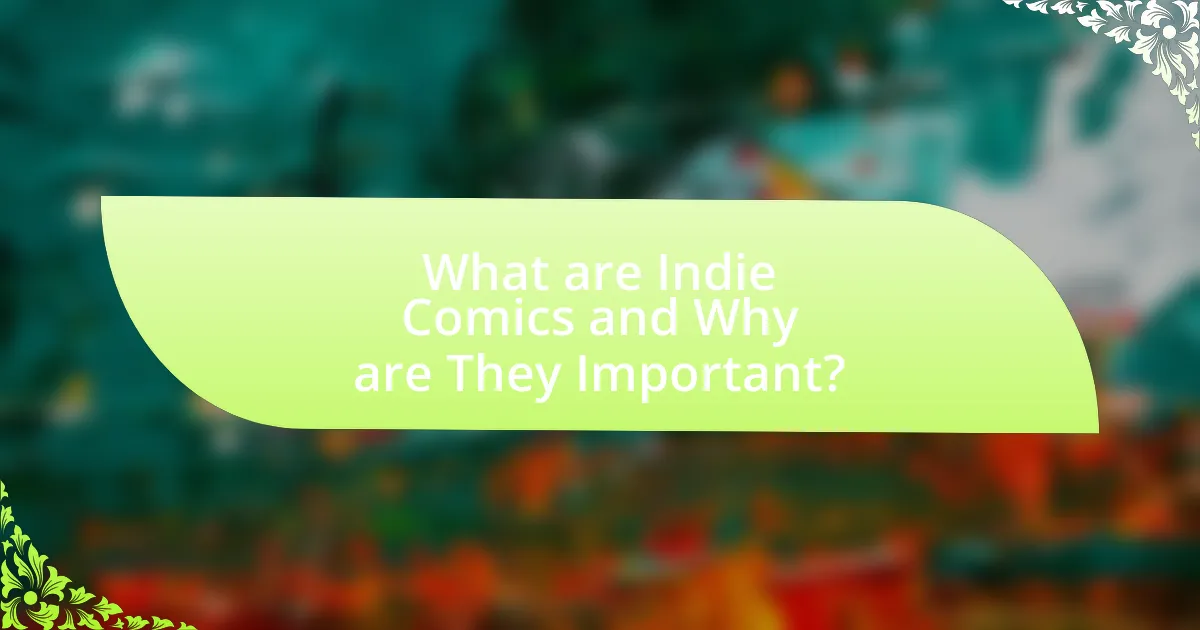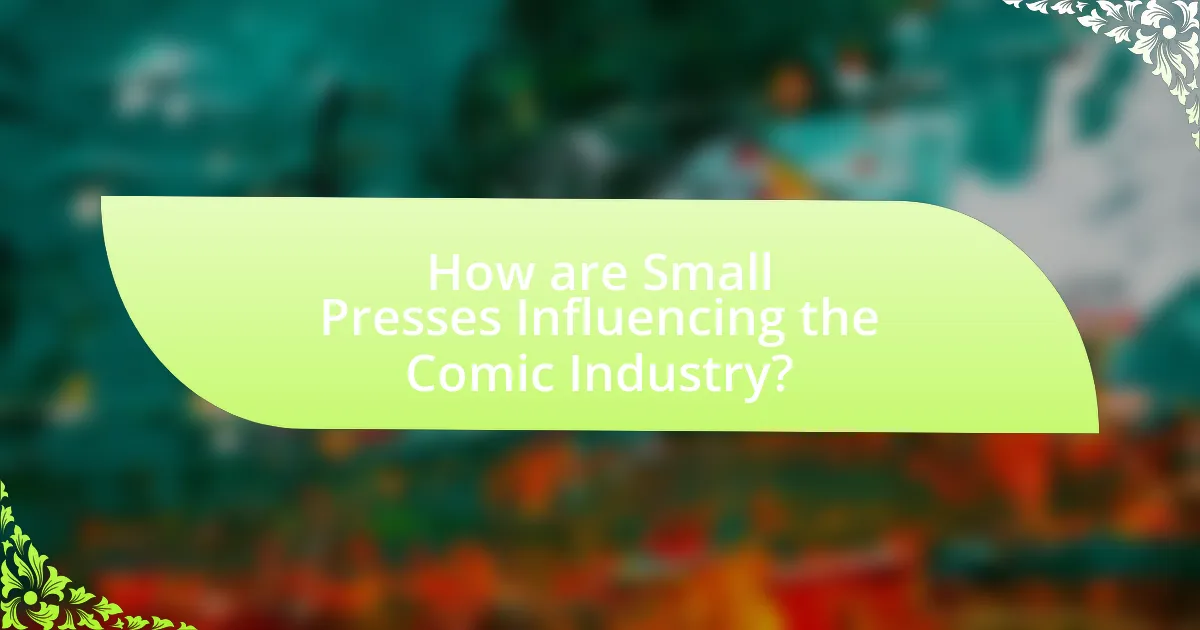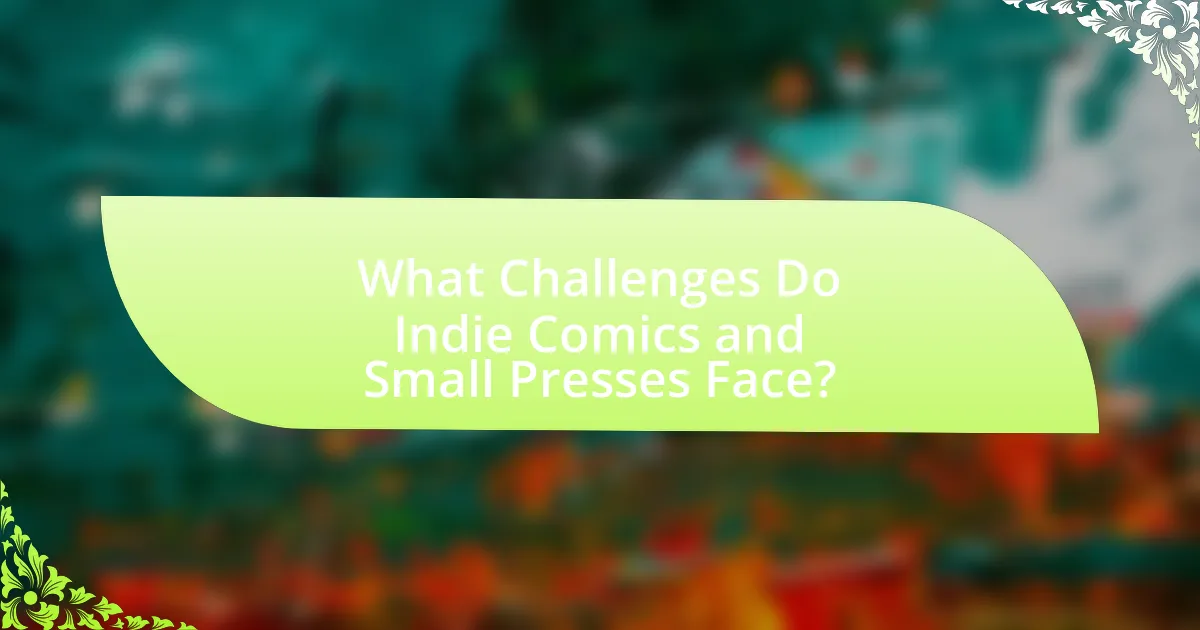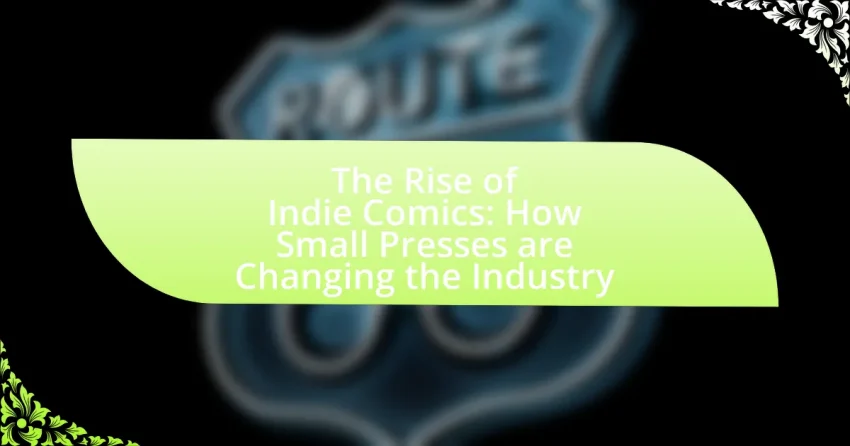Indie comics, produced independently outside major publishing houses, are gaining prominence for their creative freedom and diverse storytelling. This article explores the significance of indie comics and small presses in the comic industry, highlighting their role in amplifying underrepresented voices and innovative narratives. It examines the differences between indie and mainstream comics, the unique themes and styles prevalent in indie works, and the impact of digital platforms and crowdfunding on their popularity. Additionally, the article discusses the challenges faced by indie creators, including financial constraints and market competition, while offering insights into strategies for overcoming these obstacles and building a loyal audience.

What are Indie Comics and Why are They Important?
Indie comics are independently produced comic books that are created outside of the major publishing houses, allowing for greater creative freedom and diverse storytelling. They are important because they provide a platform for underrepresented voices, innovative art styles, and unique narratives that often challenge mainstream conventions. For instance, the rise of indie comics has led to the emergence of genres and themes that reflect a wider range of cultural experiences, as seen in works like “Saga” by Brian K. Vaughan and Fiona Staples, which blends science fiction with personal storytelling. This shift not only enriches the comic book landscape but also influences mainstream publishers to diversify their offerings, demonstrating the significant impact of indie comics on the overall industry.
How do Indie Comics differ from Mainstream Comics?
Indie comics differ from mainstream comics primarily in their creative freedom and distribution methods. Indie comics are often produced by smaller publishers or self-published creators, allowing for unique storytelling, diverse themes, and experimental art styles that may not align with the commercial interests of larger publishers. In contrast, mainstream comics typically follow established genres and formats, focusing on popular characters and franchises to maximize sales. This distinction is evident in the variety of voices and perspectives found in indie comics, which often tackle niche topics or social issues, whereas mainstream comics tend to prioritize mass appeal and marketability.
What unique themes and styles are often found in Indie Comics?
Indie comics often feature unique themes such as personal identity, social issues, and experimental storytelling. These comics frequently explore topics like mental health, LGBTQ+ representation, and cultural diversity, reflecting the creators’ individual experiences and perspectives. The styles in indie comics are diverse, ranging from minimalist art to intricate illustrations, often prioritizing artistic expression over commercial viability. This artistic freedom allows for innovative narrative techniques, such as non-linear storytelling and metafiction, which challenge traditional comic formats. The emphasis on authenticity and niche storytelling in indie comics has led to a growing audience that values unique voices and perspectives in the medium.
How do Indie Comics challenge traditional storytelling methods?
Indie comics challenge traditional storytelling methods by embracing unconventional narratives, diverse perspectives, and experimental art styles. Unlike mainstream comics, which often adhere to established genres and formulas, indie comics frequently explore personal and niche themes, allowing creators to express unique voices and stories. For instance, works like “Fun Home” by Alison Bechdel and “Saga” by Brian K. Vaughan showcase innovative storytelling techniques, such as nonlinear timelines and complex character development, which diverge from typical superhero narratives. This shift not only broadens the scope of comic storytelling but also engages a wider audience, reflecting contemporary social issues and personal experiences.
Why has the popularity of Indie Comics surged in recent years?
The popularity of Indie Comics has surged in recent years due to the increasing accessibility of digital platforms and crowdfunding, which empower creators to publish their work independently. This shift allows diverse voices and unique storytelling to flourish, attracting a wider audience. For instance, platforms like Kickstarter have enabled numerous indie projects to secure funding, with over $50 million raised for comics in 2020 alone. Additionally, the rise of social media has facilitated direct engagement between creators and fans, further boosting visibility and interest in indie titles.
What role does social media play in promoting Indie Comics?
Social media plays a crucial role in promoting Indie Comics by providing a platform for creators to reach a wider audience without the need for traditional publishing channels. Through platforms like Twitter, Instagram, and Facebook, indie comic artists can showcase their work, engage with fans, and build a community around their projects. For instance, a survey by the Comic Book Legal Defense Fund found that 70% of comic creators use social media to promote their work, highlighting its significance in the industry. Additionally, social media allows for direct interaction between creators and readers, fostering a sense of connection and support that can lead to increased sales and visibility for indie comics.
How have crowdfunding platforms impacted the Indie Comics scene?
Crowdfunding platforms have significantly transformed the Indie Comics scene by providing creators with direct access to funding and a dedicated audience. These platforms, such as Kickstarter and Indiegogo, enable independent artists to raise capital for their projects without relying on traditional publishing houses, which often impose restrictive terms. For instance, in 2020, over $25 million was pledged to comic book projects on Kickstarter alone, illustrating the financial viability and community support for indie comics. This shift has empowered creators to maintain creative control, experiment with diverse storytelling, and reach niche markets that mainstream publishers may overlook.

How are Small Presses Influencing the Comic Industry?
Small presses are significantly influencing the comic industry by fostering diversity and innovation in storytelling and artistic styles. These independent publishers provide platforms for underrepresented voices, allowing creators to explore unique narratives that mainstream publishers often overlook. For instance, small presses like Image Comics and Oni Press have successfully launched titles that challenge traditional genre boundaries and address social issues, contributing to a broader range of content available to readers. Additionally, the rise of crowdfunding platforms has enabled small presses to finance projects that might not receive backing from larger publishers, further diversifying the comic landscape. This shift has led to increased competition and creativity within the industry, as established publishers are compelled to adapt to the evolving tastes of audiences influenced by the offerings of small presses.
What are the key characteristics of Small Presses in the comic industry?
Small presses in the comic industry are characterized by their focus on niche markets, innovative storytelling, and a strong emphasis on creator-owned content. These presses often prioritize artistic freedom, allowing creators to explore unique themes and styles that may not fit within mainstream publishing. Additionally, small presses typically operate with lower overhead costs, enabling them to take risks on unconventional projects and emerging talent. This approach fosters diversity in the comic landscape, as evidenced by the increasing number of titles that address underrepresented voices and genres. Furthermore, small presses often engage directly with their audience through conventions and social media, creating a community-oriented approach that contrasts with larger publishers.
How do Small Presses support emerging artists and writers?
Small presses support emerging artists and writers by providing them with platforms to publish their work, often focusing on niche genres and diverse voices that larger publishers may overlook. These presses typically offer more accessible submission processes, allowing new talent to showcase their creativity without the barriers imposed by mainstream publishing. For instance, small presses often prioritize author development, offering mentorship and guidance throughout the publishing process, which can significantly enhance the skills and visibility of emerging creators. Additionally, small presses frequently engage in grassroots marketing efforts, helping to promote their authors through events, social media, and community outreach, thereby increasing their chances of reaching wider audiences. This support structure is crucial in an industry where many emerging artists struggle to find opportunities for exposure and publication.
What distribution methods do Small Presses utilize?
Small presses utilize a variety of distribution methods, including direct sales at conventions, online platforms, and partnerships with independent bookstores. Direct sales at conventions allow small presses to engage with their audience and sell their comics directly, often leading to higher profit margins. Online platforms, such as Etsy and their own websites, enable small presses to reach a broader audience without the overhead costs associated with physical retail spaces. Additionally, partnerships with independent bookstores help small presses gain visibility and access to local markets, as these stores often support local creators. These methods collectively enhance the reach and sustainability of small presses in the competitive comic industry.
Why are Small Presses considered vital to the diversity of comic narratives?
Small presses are considered vital to the diversity of comic narratives because they provide platforms for underrepresented voices and innovative storytelling that mainstream publishers often overlook. These independent publishers focus on niche genres, experimental art styles, and culturally specific narratives, which enrich the comic landscape. For instance, small presses like Fantagraphics and Drawn & Quarterly have published works that explore themes of identity, social justice, and personal experiences, contributing to a broader range of perspectives in the medium. This diversification is essential for fostering creativity and ensuring that a variety of cultural narratives are accessible to audiences, ultimately reflecting the complexity of society.
How do Small Presses contribute to underrepresented voices in comics?
Small presses contribute to underrepresented voices in comics by providing platforms for diverse creators who may not find opportunities in mainstream publishing. These small presses often prioritize inclusivity, allowing marginalized artists and writers to share their stories and perspectives. For instance, small presses like Image Comics and Oni Press have published works that explore themes of race, gender, and sexuality, which are often overlooked by larger publishers. This commitment to diversity not only enriches the comic book landscape but also reflects a broader range of human experiences, making the medium more accessible and relatable to a wider audience.
What impact do Small Presses have on genre exploration in comics?
Small presses significantly enhance genre exploration in comics by providing a platform for diverse and unconventional narratives. Unlike mainstream publishers, small presses often prioritize artistic expression and innovation over commercial viability, allowing creators to experiment with genres that may not fit traditional molds. For instance, small presses have been instrumental in popularizing genres such as memoir, horror, and experimental fiction within the comic medium, as seen in works like “Fun Home” by Alison Bechdel and “The Arrival” by Shaun Tan. These publications often reach niche audiences, fostering a richer and more varied landscape in the comic industry, which encourages both creators and readers to engage with a broader spectrum of storytelling.

What Challenges Do Indie Comics and Small Presses Face?
Indie comics and small presses face significant challenges, primarily including limited financial resources, distribution difficulties, and market saturation. Financial constraints hinder their ability to produce high-quality content and invest in marketing, which is crucial for visibility. Distribution is often problematic due to reliance on small retailers and online platforms that may not prioritize indie titles, leading to reduced sales opportunities. Additionally, the market is saturated with numerous titles, making it difficult for new entrants to stand out and gain readership. According to a 2021 report by the Comic Book Industry Alliance, over 4,000 new comic titles were released annually, intensifying competition for indie creators.
What are the financial hurdles for Indie Comics creators?
Indie comics creators face significant financial hurdles, primarily due to limited access to funding and distribution channels. Many creators struggle to secure initial capital for production costs, which can include printing, artwork, and marketing expenses. According to a survey by the Comic Book Legal Defense Fund, 70% of independent creators reported that financial constraints hindered their ability to produce and distribute their work effectively. Additionally, the lack of established distribution networks means that indie comics often rely on direct sales at conventions or online platforms, which can limit their reach and revenue potential. This financial landscape creates barriers that can stifle creativity and innovation within the indie comics sector.
How do marketing and visibility challenges affect Indie Comics?
Marketing and visibility challenges significantly hinder the success of indie comics by limiting their audience reach and sales potential. Indie comics often lack the marketing budgets and resources that larger publishers possess, resulting in reduced exposure in a crowded marketplace. According to a 2021 survey by the Comic Book Legal Defense Fund, 70% of indie creators reported difficulties in gaining visibility for their work, which directly correlates with lower sales figures. This lack of visibility can lead to missed opportunities for distribution and promotion, ultimately stifling the growth and sustainability of indie comic creators and their projects.
What competition do Indie Comics face from larger publishers?
Indie comics face significant competition from larger publishers primarily due to their established distribution networks and marketing resources. Larger publishers, such as Marvel and DC, have extensive reach in retail and digital platforms, allowing them to dominate shelf space and visibility. This dominance is supported by their substantial marketing budgets, which enable them to promote their titles effectively across various media channels. For instance, in 2021, the market share of the top five comic book publishers accounted for over 80% of total sales, illustrating the challenge indie comics face in gaining market traction. Additionally, larger publishers often have the ability to attract high-profile creators, further enhancing their appeal and consumer interest.
How can Indie Comics and Small Presses overcome these challenges?
Indie comics and small presses can overcome challenges by leveraging digital platforms for distribution and marketing. By utilizing social media, crowdfunding, and online marketplaces, these entities can reach wider audiences without the constraints of traditional publishing. For instance, platforms like Kickstarter have enabled creators to fund projects directly through consumer support, with over $1 billion pledged to comic projects since its inception. Additionally, indie comics can focus on niche markets and unique storytelling to differentiate themselves from mainstream offerings, which can attract dedicated fan bases. This strategic approach not only enhances visibility but also fosters community engagement, essential for sustaining growth in a competitive industry.
What strategies can creators use to build a loyal audience?
Creators can build a loyal audience by consistently engaging with their community through social media, newsletters, and interactive content. This strategy fosters a sense of belonging and connection, which is crucial for audience retention. For instance, indie comic creators often share behind-the-scenes content, respond to fan inquiries, and host live Q&A sessions, which enhances audience investment in their work. Research indicates that creators who maintain regular communication with their audience see a 30% increase in engagement rates, demonstrating the effectiveness of this approach.
How can collaboration among creators enhance the Indie Comics landscape?
Collaboration among creators can significantly enhance the Indie Comics landscape by fostering innovation and expanding creative boundaries. When artists, writers, and publishers work together, they combine diverse skills and perspectives, leading to unique storytelling and artistic styles that can attract a wider audience. For instance, successful collaborations like those seen in anthologies or shared universes often result in increased visibility and sales for individual creators, as seen with projects like “The Adventure Zone” which brought together various talents to create a compelling narrative. This collaborative approach not only enriches the content but also builds a supportive community that can share resources, marketing strategies, and distribution channels, ultimately strengthening the Indie Comics market as a whole.
What are the best practices for aspiring Indie Comics creators?
Aspiring Indie Comics creators should focus on developing a unique voice and style while mastering storytelling and visual art. Establishing a strong narrative is crucial, as compelling stories engage readers and differentiate creators in a crowded market. Additionally, creators should invest time in honing their artistic skills, as high-quality visuals are essential for capturing audience interest.
Networking within the indie comics community is also vital; attending conventions and participating in online forums can lead to valuable connections and collaborations. Furthermore, creators should utilize social media platforms to build an audience and promote their work, as effective marketing can significantly enhance visibility and sales.
Finally, understanding the business side of comics, including budgeting, distribution, and copyright issues, is essential for long-term success. According to a survey by the Comic Book Legal Defense Fund, 70% of indie creators reported that knowledge of the industry helped them navigate challenges effectively.
How can creators effectively utilize social media for promotion?
Creators can effectively utilize social media for promotion by strategically engaging with their audience and leveraging platform-specific features. Engaging content, such as behind-the-scenes looks, interactive polls, and live Q&A sessions, fosters community and encourages sharing. For instance, platforms like Instagram and TikTok are particularly effective for visual storytelling, allowing creators to showcase their artwork and process, which can lead to increased visibility and follower growth. According to a 2021 report by Hootsuite, 54% of social media users use these platforms to research products, indicating that creators can attract potential readers by sharing compelling content. Additionally, utilizing hashtags relevant to indie comics can enhance discoverability, as posts with at least one hashtag receive 12.6% more engagement than those without.
What resources are available for Indie Comics creators to improve their craft?
Indie Comics creators can improve their craft through various resources, including online courses, workshops, and community forums. Platforms like Skillshare and Udemy offer courses specifically tailored to comic creation, covering topics such as storytelling, character design, and digital art techniques. Additionally, organizations like the Comic Book Legal Defense Fund provide workshops and resources focused on the business and legal aspects of comics, which are crucial for independent creators. Community forums such as Reddit’s r/comicbookcollabs and the Digital Webbing forum allow creators to share feedback, collaborate, and gain insights from peers. These resources collectively enhance the skills and knowledge necessary for Indie Comics creators to thrive in a competitive industry.
